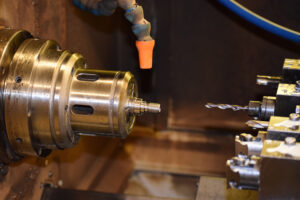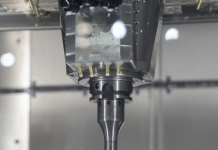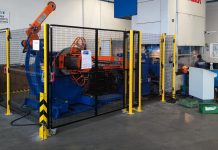Reliable domestic retention knobs utilizing superior U.S. steel can enhance set-up rigidity, which improves tool life and cycle times.
 Contract machine shops and OEMs rely on CNC milling machines to produce very precise components in industries such as medical, aerospace, automotive, motorcycle, and gun manufacturing. However, consistently achieving precisely machined components requires a quality retention knob, particularly in high-speed, high-volume applications. In milling machines, retention knobs are commonly used with tapered tool holders to engage drawbars that hold the tool holder firmly in the spindle. The tapered tool holder comes with threads designed to accept the retention knob, but any improper seating of V-flange toolholders costs manufacturers in lost productivity. It also causes run-out and vibration that reduces the precision of machining while reducing tool & spindle life. This is an extremely common problem in machining. Beyond this, high-speed machining in excess of 20,000 RPMs is often utilized in aerospace, medical, and other industries when machining exotic alloys and harder metals like titanium. At the higher RPMs, the precise and secure seating of tapered toolholders in the spindle (with the help of the retention knob) is even more critical. So much so, that failing to pay attention to this single detail can lead to further decreased productivity, less precise machining, reduced tool life, and even damaged workpieces. That is why strong, well-manufactured retention knobs are so important. A superior product increases the rigidity of the set-up, which increases tool life and speeds cycle times (the measure of the time it takes to complete each part from start to finish.)
Contract machine shops and OEMs rely on CNC milling machines to produce very precise components in industries such as medical, aerospace, automotive, motorcycle, and gun manufacturing. However, consistently achieving precisely machined components requires a quality retention knob, particularly in high-speed, high-volume applications. In milling machines, retention knobs are commonly used with tapered tool holders to engage drawbars that hold the tool holder firmly in the spindle. The tapered tool holder comes with threads designed to accept the retention knob, but any improper seating of V-flange toolholders costs manufacturers in lost productivity. It also causes run-out and vibration that reduces the precision of machining while reducing tool & spindle life. This is an extremely common problem in machining. Beyond this, high-speed machining in excess of 20,000 RPMs is often utilized in aerospace, medical, and other industries when machining exotic alloys and harder metals like titanium. At the higher RPMs, the precise and secure seating of tapered toolholders in the spindle (with the help of the retention knob) is even more critical. So much so, that failing to pay attention to this single detail can lead to further decreased productivity, less precise machining, reduced tool life, and even damaged workpieces. That is why strong, well-manufactured retention knobs are so important. A superior product increases the rigidity of the set-up, which increases tool life and speeds cycle times (the measure of the time it takes to complete each part from start to finish.)
The problem is poorly designed retention knobs from overseas are often made of low-quality steel that may be prone to breaking during machining. Newer CNC milling machines exert significantly more drawbar pressure on retention knobs than in the past. As drawbar tension continues to increase in CNC machines, it puts so much pressure on the retention knob, that it may be more likely to break if not manufactured to the highest standard.
Tips & tricks
Retention knob failures may fail due to other reasons, including improper knob configuration, misaligned machines, metal fatigue, over-torqueing and exceeding the machine’s capability. That is why it is essential to periodically inspect each retention knob for signs of excessive wear, damage, or corrosion. If found, the retention knob should be replaced. “We deal with a lot of aerospace companies, some with high-speed CNC applications with harder metals or alloys,” says Bob Selleck, Manager at SAG Supply, a Long Island, NY-based provider of high-quality industrial tools, machinery and accessories. “For that, you need a reliable retention knob that will last without breaking or moving. It needs to hold everything tightly in place with precision.” Although retention knobs often look very similar, they are not interchangeable. The materials, coatings applied, and the quality of manufacturing can be important differentiators. Another consideration is where the item is manufactured, given that some overseas imports have a reputation for lower quality. “Some [retention knob] imports do not always fit snugly or precisely in the flange and may wobble or move a little bit under high-speed applications,” adds Selleck. The most reliable retention knobs are those made with superior U.S. steel and coated with black oxide, to prevent corrosion. In addition, the retention knobs should be subjected to the most rigorous quality control standards, including frequent inspection by the manufacturer.



